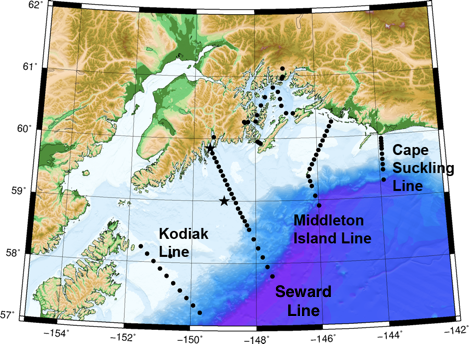
In a few short days, 23 scientists and educators will embark on our first LTER cruise aboard the R/V Sikuliaq, April 18 – May 5, 2018. Cruises are integral to our research and we anticipate having three each year – in May, July, and September. This cruise continues decades of time-series of measurements of the spring phytoplankton bloom along the Seward Line. As such, its many objectives center on the physical and biological processes that generate and sustain the spring bloom.
Scientific Purpose
This cruise continues the sampling begun in fall 1997 under the NSF/NOAA NE Pacific GLOBEC program, and supported subsequently a consortium of the North Pacific Research Board (NPRB), the Alaska Ocean Observing System (AOOS), and the Exxon Valdez Oil Spill Trustee Council’s (EVOSTC) Gulf Watch. This is the first cruise as part of the NSF’s Northern Gulf of Alaska Long-term Ecological Program (NGA-LTER). The core scientific purpose of the Seward Line project is to develop an understanding of the response and resiliency of this marine ecosystem to climate variability. This cruise marks the 21st consecutive spring cruise for the Seward Line in the NGA, including Prince William Sound (PWS), and the 48th year of observations at GAK1.
Cruise Objectives

- Determine thermohaline, velocity, light, and oxygen structure of the NGA shelf.
- Determine macro- and micro-nutrient structure of the NGA shelf.
- Determine particle structure and flux rates of the NGA shelf.
- Determine phyto- and microzooplankton composition, biomass distribution, and productivity.
- Determine the vertical and horizontal distribution and abundance of zooplankton species (including macro-jellies).
- Record multi-frequency acoustics for estimation of nekton
- Conduct surveys of seabirds and Marine Mammals
- Conduct shipboard experimental work on phyto- and zooplankton.
- Determine carbonate chemistry (i.e. Ocean Acidification) at selected stations
- Recover and redeploy the GAK1 mooring. Drag for lost mooring at GAK 4 and Gak8i.
- Provide at-sea experience for UAF students.
- Share the experience through outreach/media activities.
Sampling Plan
To achieve the objectives, the cruise will visit four cross-shelf transect lines plus stations within Prince William Sound. At each station, operations will be divided into day and night tasks. In the day, we will perform CTD measurements, bottle sampling, and perform intensive sampling and productivity experiments at selected locations. At night, net tows for zooplankton will catch the critters when they rise in the water column to feed. The shortness of high latitude nights in May will mean more daylight work than nighttime work.
